The New Art of Self Defence
By E. W. Barton-Wright
Part 2
From Pearson's Magazine, March-April 1899Part 1
Readers of the March number will remember that I described therein a few of the three hundred methods of attack and counter attack that comprise my New Art of Self-Defence, to which I have given the name "Bartitsu". For the benefit of new readers, it will be well to point out that my system has been devised with the purpose of rendering a person absolutely secure from danger by any method of attack that may arise. It is not intended to take the place of boxing, fencing, wrestling, savate, or any other recognised forms of attack and defence. This, however, is claimed for it - it comprises all the best points of these methods, and will be of inestimable value when occasions arise where neither boxing, nor wrestling, nor any of the other known modes of resistance is of avail. The system has been carefully and scientifically planned; its principle may be summed up in a sound knowledge of balance and leverage as applied to human anatomy.
No. 1.-- How to Put a Troublesome Man Out of the Room
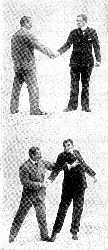 In introducing a further selection of these feats, it may be
as well to mention again the fact that there is not one
among them that any person of average strength could not
learn and perform. Some are so simple that they will be
understood at once, and expeditiously performed after only a
few trials. Others will require a certain amount of
practice before being mastered.
In introducing a further selection of these feats, it may be
as well to mention again the fact that there is not one
among them that any person of average strength could not
learn and perform. Some are so simple that they will be
understood at once, and expeditiously performed after only a
few trials. Others will require a certain amount of
practice before being mastered.
We will suppose, in the first case, that some undesirable person comes into your room, and that you are anxious to march him out again without delay. You find that persuasion and commands alike fail; he may be a bigger man than yourself, and you may hesitate to propel him out of your door by the common method. By adopting the following plan your visitor will give you no further trouble:
Seize his right wrist with your right hand, turning the inside of his arm upwards, as shown in the first photograph. Then step towards him with your left foot, pass y our left arm under his right upper arm, and seize hold of the lappet of his coat, so as to support your left arm and prevent it from slipping downwards.
Now exert downward pressure upon your victim's arm, and with the leverage so obtained you could, if he attempted to resist you, break his arm at the elbow.
In this position you will have not the slightest difficulty in compelling him to walk out of the room.
No. 2.-- One of Many Ways of Throwing a Man, without Exerting Strength, when you Seize him from Behind.
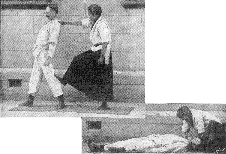 Seize the man by the collar of his coat from behind, and
place your foot behind his knee. Pull with your hand, and
press with your foot, and he will be at once deposited upon
his back!
Seize the man by the collar of his coat from behind, and
place your foot behind his knee. Pull with your hand, and
press with your foot, and he will be at once deposited upon
his back!
Without releasing your hold upon his collar, pass your right hand around his neck, so that you can bring your fore-arm across his throat. Then, seizing the right lappet of his coat with your left hand to prevent the coat from moving, you bear down with all your weight across his wind-pipe with your right arm, and so render him powerless to resist, and--if need be--throttle him!
No. 3.-- How to Hold a Man on the Ground in such a Position that He is Unable to Move.
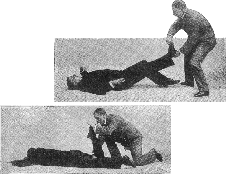 As promptly as possible, seize your opponent's foot. Then,
if you twist it smartly in the way indicated in the first
illustration, you will find no difficulty in turning him on
his face.
As promptly as possible, seize your opponent's foot. Then,
if you twist it smartly in the way indicated in the first
illustration, you will find no difficulty in turning him on
his face.
Immediately this has been done, release the hold of one hand, and place your fore-arm tightly behind his knee, as shown in photograph No. 2. Then, by forcing the foot backwards, you can exert such leverage that if your opponent should still attempt to resist, you could break both his knee and his ankle.
No. 4.-- How to Overthrow an Assailant who Attacks you from Behind, and Pinions your Arms.
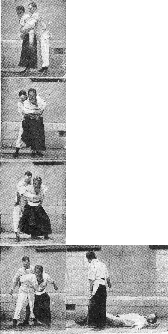 It might be supposed that if a man were attacked from
behind, and found that his assailant had pinioned his arms,
it would be a difficult matter for him to release himself.
This, however, is by no means the case, and by carefully
following the directions given below it will be seen that it
is a simple feat for a man, not only to release himself when
attacked in the manner described, but also to throw his
assailant heavily to the ground without exerting
extraordinary strength.
It might be supposed that if a man were attacked from
behind, and found that his assailant had pinioned his arms,
it would be a difficult matter for him to release himself.
This, however, is by no means the case, and by carefully
following the directions given below it will be seen that it
is a simple feat for a man, not only to release himself when
attacked in the manner described, but also to throw his
assailant heavily to the ground without exerting
extraordinary strength.
Directly your arms are pinioned, raise your right foot, as shown in the second photograph, and stamp heavily on your assailant s right foot. This immediately causes him to draw it back, in order to keep out of range of further danger. You then grasp his right leg with your right hand, in the precise position shown in the third photograph, exerting as much pressure as possible with your thumb. By this means you will cause your opponent such pain that he will instinctively loosen his hold.
You immediately take advantage of this opportunity to place your right arm round his body, and your right leg behind his knee. Then striking him behind the knee with the inside of your leg, and accompanying the movement with a left to right swing of your body, you cause him to lose his balance, and throw him heavily upon his back.
When a man attacks you from behind, and pinions your arms as shown in the first photograph, his intention will probably be to hold you securely whilst a confederate attacks you from the front. With your arms pinioned, your pockets and valuables are, of course, at the mercy of your assailants.
There are, of course, other methods of disposing of an adversary who attacks in this way; the one illustrated, however, is the simplest and most effective, and has the additional advantage of requiring no strength whatever.
It may be well to explain here why my vis-a-vis, who figures in the majority of the feats is a Japanese, in Japanese costume. It was in Japan that I picked up the ideas for many of the methods in this new art of self-defence. The Japanese have long been famed as wrestlers, many of the tricks they employ to overcome their adversaries being remarkably ingenious.
No. 5.-- How to Overthrow an Assailant who Seizes both your Wrists.
 In this case we will suppose that you are suddenly attacked
in such a way that both your wrists are held captive by your
assailant. The advantage is, of course, with him, but he
will, however, be easily overthrown if the following tactics
are carried out.
In this case we will suppose that you are suddenly attacked
in such a way that both your wrists are held captive by your
assailant. The advantage is, of course, with him, but he
will, however, be easily overthrown if the following tactics
are carried out.
Your assailant will probably face you with his right foot forward. In this respect you follow his example. Then seize his left wrist with your left hand; release your right wrist by pushing your arm suddenly downwards.
Seize your opponent's right wrist with your released right hand, and, with a jerk downwards, cause him to release his hold of your left wrist. As soon as you have done this, draw his right arm over his left fore-arm, so that the back of the elbow passes across the centre of his left arm. Follow up the movement by raising his left arm, and bearing down upon his right arm.
The result will be instantaneous, and very surprising to your opponent, who will be forced to turn a somersault in the air, and will fall heavily on his back. Still retaining your hold on his wrists, you will now have him completely at your mercy.
In performing this feat upon your friends, it is not necessary to force them to turn a somersault from the position shown in illustration No. 2; but directly you have crossed your adversary's arms, and can apply the leverage, bend down yourself as much as possible, so as to nearly touch the ground. This will obviate the necessity of your friend running any risks of hurting himself by turning a somersault, and you can easily roll him over upon his back without any effort, as shewn in the third and last illustration.
Be careful not to apply this leverage with a jerk, but gradually, otherwise you may unintentionally injure your friend's arm.
No. 6.-- When Seized by the Lappets of the Coat, how to Release yourself, and Overthrow your Assailant.
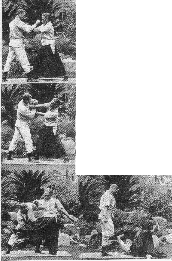 When a man seizes you by the lappets of your coat, he
forgets or often overlooks the fact that in this method of
attack his face is undefended. Your first movement will be,
therefore, to strike him (or if you are practising the feats
with a friend pretend to strike him) in the face with your
right fist.
When a man seizes you by the lappets of your coat, he
forgets or often overlooks the fact that in this method of
attack his face is undefended. Your first movement will be,
therefore, to strike him (or if you are practising the feats
with a friend pretend to strike him) in the face with your
right fist.
This advice may seem unnecessary. It is not, however, so often followed, for the chances are that, when the occasion arises to which it applies, you will follow the natural and instinctive desire to free yourself by placing your hands upon your opponent's arms, and pressing upon them, which is as feeble as it is an unavailing method of resistance.
Remember, then, that your first movement should be to strike your assailant in the face with your right fist. If this does not cause him to release his hold, follow up the movement by passing your right forearm between his outstretched arms, and bring your right fore-arm up on the outer side of his right forearm. Then grasp your right wrist with your left hand, and with the leverage thus obtained you may easily force his arm upwards, and break his hold.
This movement of breaking the hold should be made with suddenness and a quick jerk if your opponent be a strong man with a powerful grip. He will then be partially turned round. Take the opportunity to place your left leg behind him, and. passing your left fore-arm across his chest, and seizing his right leg as shown in the third photograph, you proceed to tip him over backwards.
No. 7.-- If a Man Seizes you by the Coat and Attempts to Shake you, how to Release Yourself, and to Overthrow your Assailant.
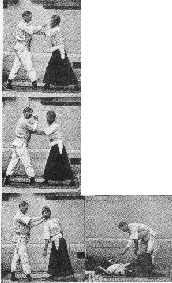 It is very humiliating to be shaken. It is also very
unpleasant. I have once seen the operation performed on a
man, and I shall never forget the helpless, hopeless
expression on his face, as his head jerked violently
backwards and forwards, and his body swayed in every
direction, and he was finally sent crashing to the ground.
It is very humiliating to be shaken. It is also very
unpleasant. I have once seen the operation performed on a
man, and I shall never forget the helpless, hopeless
expression on his face, as his head jerked violently
backwards and forwards, and his body swayed in every
direction, and he was finally sent crashing to the ground.
A severe shaking is a very real and terrible punishment, as those who have been so unfortunate as to have experienced it will testify. And it is a method of attack that is by no means uncommon, being especially resorted to by strong, big men, who pride themselves upon their strength and weight, and hesitate to strike a small mall in case it should be thought cowardly. A good shaking like this will very soon reduce the victim to a state of thorough collapse. It is well, therefore, to know how to overthrow an opponent who seizes you by the coat and attempts to shake you.
The following method will be found very effective:
Directly you are seized, strike your assailant, simultaneously with both fists, in the face, and bring your elbows down very sharply upon his wrists, which will have the effect of breaking his hold and jerking his head slightly forwards and downwards for a moment.
You immediately take this opportunity to catch him by the head, placing your right hand behind his head, and the hollow of your left hand under his chin. Then, stepping towards him with your left foot, and bringing your right foot behind your left foot (which acts as a sort of pivot to enable you to transmit a circular motion or twist to the neck) you throw him heavily upon his back.
No. 8.-- One of Many Ways of Defending yourself, when a Man Strikes at your Face with his Right Fist.
I have already shown one method of dealing with an assailant when he attempts to strike you in the face. Here is an alternative plan, very terrible in effect.
When considering the advantages of this new art of self-defence, it must be remembered that there are times when no method is too severe to be adopted in order to overthrow an assailant. But, of course, the following method would not be carried to its extreme except in a very critical case.

Guard the blow by receiving it on your right fore-arm. Slip your hand up your assailant's arm and grasp him by the wrist with finger and thumb, at the same time pulling him slightly forwards, and seizing him by the elbow with your left hand.
He will instinctively resist you when you are pulling him towards you with your right hand. You take advantage of this moment to reverse the motion and bend his arm backwards as shown in the fourth illustration.
You then step forward and place your right leg behind his right leg, and, pushing his right elbow in an inward and upward direction, and his hand in an outward and downward direction, you cause him such pain that he is obliged to fall over backwards.
Retaining your hold, you keep him down on the ground in this position, and so great is your power that if you wished you could now break his arm.
Of course, the same feat can be performed when a man strikes at you with his left hand or left fist, when you receive the blow on your left fore-arm, seize his left wrist, and then proceed to throw him, as described above.

No. 9.-- One of Many Ways of Releasing yourself when Seized by the Coat Collar from Behind.
 Perhaps one of the commonest forms of attack is that in
which an assailant makes a rush at his victim from behind,
and seizes him by the collar of his coat.
Perhaps one of the commonest forms of attack is that in
which an assailant makes a rush at his victim from behind,
and seizes him by the collar of his coat.
Were you attacked in this way, you might suppose that your position rendered you helpless, that the advantage was all on your adversary's side, that you could not use your hands with any great effect, and that you would probably-be hurled at once on to your back:
In order to avoid this mischance, you must act promptly.
Directly you are grasped by the collar you must turn round and face your assailant, seizing him just behind the elbow with the thumb and finger of your left hand. Then exert pressure upon the nerve of the funny bone, which is situated just behind the elbow.
This will cause your assailant unendurable pain, and he will immediately release his hold. Then, without releasing your hold, throw his arm upwards with your left hand, step forward with your right foot, and place it behind his right leg
It will then be found a comparatively simple matter to seize him by the throat with your right hand, and throw him upon his back.
It may be argued that it is a difficult matter to find and press upon your assailant's funny bone in a moment of danger, especially if he is wearing a heavy coat, through which your pressure would have but little effect. This, undoubtedly, is the case, and some little practice is required before it is possible to immediately place your thumb upon the tender spot. However, the feat is not so difficult as anyone would imagine who has not made the attempt.
Should it be found difficult to release your opponent's hold in the manner described, a sharp upward blow at the elbow joint will have the desired effect. The arm must be seized instantly, when released! by the left hand, and held upright; and then the method of throwing must be continued as described above.
No. 10.-- How to Overthrow an Opponent who Seizes you by the Right Arm
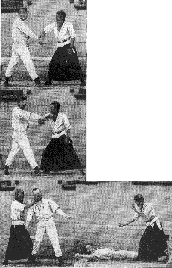 The four little photographs produced herewith show a very
pretty and effectual method of overthrowing an assailant who
seizes you by the right wrist with both hands.
The four little photographs produced herewith show a very
pretty and effectual method of overthrowing an assailant who
seizes you by the right wrist with both hands.
As soon as your arm is seized, as shown in the first photograph. you raise your hand in front of your chest towards your left shoulder. But if your opponent is too heavy and strong to admit of your doing this, you must step slightly towards him with your right foot and bend your knees sufficiently to admit of your hand being nearly level with your left shoulder.
Then straighten your knees and turn sideways to him. You will at once feel that you can break his hold whenever you please. Directly this stage has been reached, re-arrange your feet in such a way that you may exert your strength to the best advantage in the direction you desire - i.e., so that you may easily throw your assailant off with a sweep of the arm. But before using your strength, bend your knees well, in order to be well under your work. Then, with a vigorous movement of your arm, accompanied by the lifting movement supplied by straightening your knees, you throw him off his balance, and turn him partly round, so that your right hand comes in front of his face.
Now take a long step behind him with your left foot, seize him by the chin with your right hand, and by the back of the head with your left hand. Then, by bringing your left foot back again with a long stride behind your right, you impart a circular twist to your assailant's head and neck, which will throw him heavily upon his back.
Those who wish to become better acquainted with this new system should communicate directly to the writer, who intends in the future, all being well, to open a school for the study of the New Art of Self Defence.